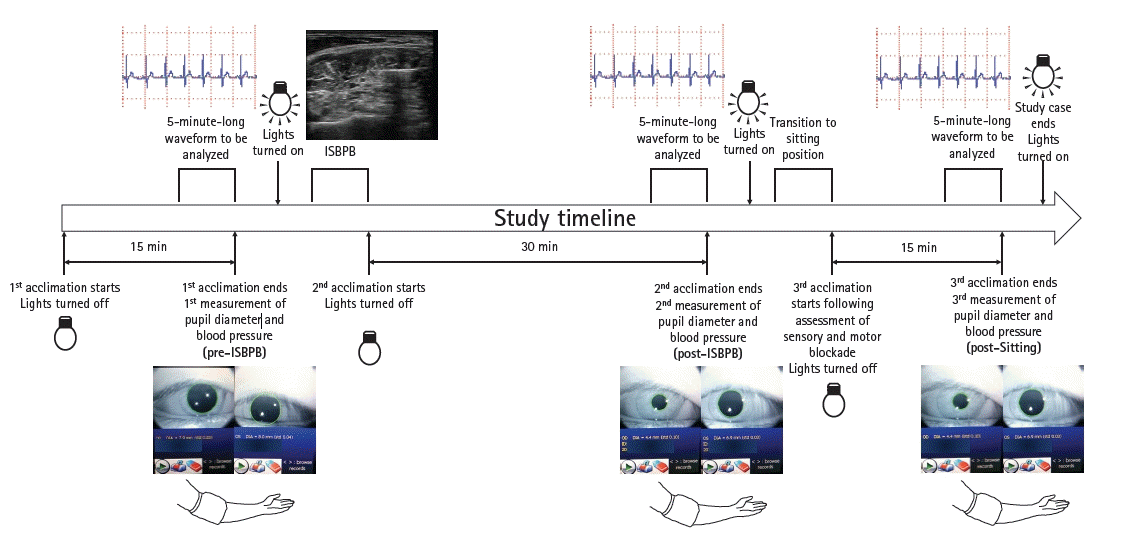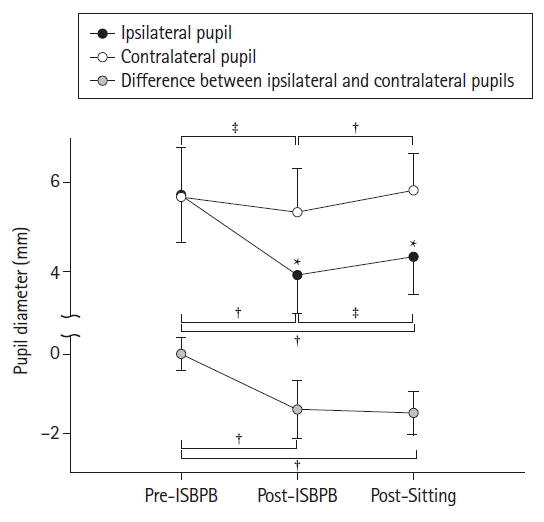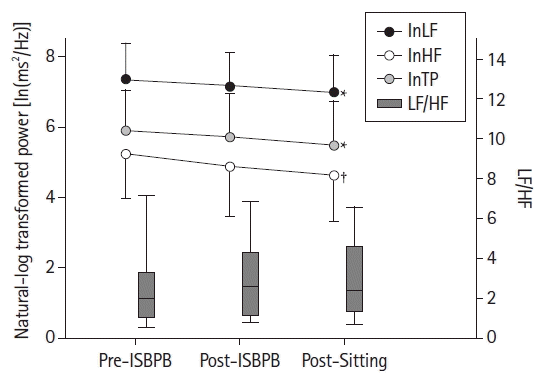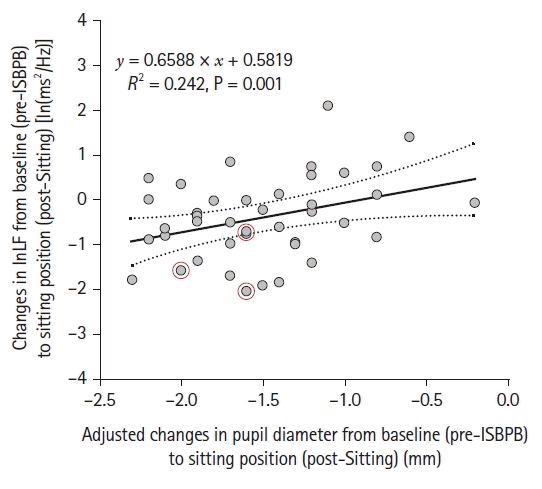1. Kim E, Choi CH, Kim JH. Effects of C8 nerve root block during interscalene brachial plexus block on anesthesia of the posterior shoulder in patients undergoing arthroscopic shoulder surgery: study protocol for a prospective randomized parallel-group controlled trial. Trials. 2019; 20:533.
2. Ryu T, Kil BT, Kim JH. Comparison between ultrasound-guided supraclavicular and interscalene brachial plexus blocks in patients undergoing arthroscopic shoulder surgery: a prospective, randomized, parallel study. Medicine (Baltimore). 2015; 94:e1726.
3. Basaran B, Yilbas AA, Gultekin Z. Effect of interscalene block on intraocular pressure and ocular perfusion pressure. BMC Anesthesiol. 2017; 17:144.
4. Wink J, van Delft R, Notenboom RG, Wouters PF, DeRuiter MC, Plevier JW, et al. Human adult cardiac autonomic innervation: controversies in anatomical knowledge and relevance for cardiac neuromodulation. Auton Neurosci. 2020; 227:102674.
5. Wittwer ED, Radosevich MA, Ritter M, Cha YM. Stellate ganglion blockade for refractory ventricular arrhythmias: implications of ultrasound-guided technique and review of the evidence. J Cardiothorac Vasc Anesth. 2020; 34:2245–52.
6. Tian Y, Wittwer ED, Kapa S, McLeod CJ, Xiao P, Noseworthy PA, et al. Effective use of percutaneous stellate ganglion blockade in patients with electrical storm. Circ Arrhythm Electrophysiol. 2019; 12:e007118.
7. Cha YM, Li X, Yang M, Han J, Wu G, Kapa SC, et al. Stellate ganglion block and cardiac sympathetic denervation in patients with inappropriate sinus tachycardia. J Cardiovasc Electrophysiol. 2019; 30:2920–8.
8. Peruto CM, Ciccotti MG, Cohen SB. Shoulder arthroscopy positioning: lateral decubitus versus beach chair. Arthroscopy. 2009; 25:891–6.
9. Nacitarhan V, Elden H, Kisa M, Kaptanogglu E, Nacitarhan S. The effects of therapeutic ultrasound on heart rate variability: a placebo controlled trial. Ultrasound Med Biol. 2005; 31:643–8.
10. Koyama S, Sato N, Nagashima K, Aizawa H, Kawamura Y, Hasebe N, et al. Effects of right stellate ganglion block on the autonomic nervous function of the heart: a study using the head-up tilt test. Circ J. 2002; 66:645–8.
11. Kinsella SM, Tuckey JP. Perioperative bradycardia and asystole: relationship to vasovagal syncope and the bezold-jarisch reflex. Br J Anaesth. 2001; 86:859–68.
12. Masuda A, Fujiki A. Sinus arrest after right stellate ganglion block. Anesth Analg. 1994; 79:607.
13. Valenza G, Citi L, Saul JP, Barbieri R. Measures of sympathetic and parasympathetic autonomic outflow from heartbeat dynamics. J Appl Physiol (1985). 2018; 125:19–39.
14. Goldstein DS, Bentho O, Park MY, Sharabi Y. Low-frequency power of heart rate variability is not a measure of cardiac sympathetic tone but may be a measure of modulation of cardiac autonomic outflows by baroreflexes. Exp Physiol. 2011; 96:1255–61.
15. Boyett M, Wang Y, D’Souza A. CrossTalk opposing view: Heart rate variability as a measure of cardiac autonomic responsiveness is fundamentally flawed. J Physiol. 2019; 597:2599–601.
16. Malik M, Hnatkova K, Huikuri HV, Lombardi F, Schmidt G, Zabel M. Crosstalk proposal: heart rate variability is a valid measure of cardiac autonomic responsiveness. J Physiol. 2019; 597:2595–8.
17. Posada-Quintero HF, Dimitrov T, Moutran A, Park S, Chon KH. Analysis of reproducibility of noninvasive measures of sympathetic autonomic control based on electrodermal activity and heart rate variability. IEEE Access. 2019; 7:22523–31.
18. Bourdillon N, Schmitt L, Yazdani S, Vesin JM, Millet GP. Minimal window duration for accurate HRV recording in athletes. Front Neurosci. 2017; 11:456.
19. Kaltsatou A, Hadjigeorgiou GM, Grigoriou SS, Karatzaferi C, Giannaki CD, Lavdas E, et al. Cardiac autonomic function during intradialytic exercise training. Postgrad Med. 2019; 131:539–45.
20. Kaltsatou A, Kouidi E, Fotiou D, Deligiannis P. The use of pupillometry in the assessment of cardiac autonomic function in elite different type trained athletes. Eur J Appl Physiol. 2011; 111:2079–87.
21. Bar KJ, Schulz S, Koschke M, Harzendorf C, Gayde S, Berg W, et al. Correlations between the autonomic modulation of heart rate, blood pressure and the pupillary light reflex in healthy subjects. J Neurol Sci. 2009; 279:9–13.
22. Okutucu S, Civelekler M, Aparci M, Sabanoglu C, Dikmetas O, Aksoy H, et al. Computerized dynamic pupillometry indices mirrors the heart rate variability parameters. Eur Rev Med Pharmacol Sci. 2016; 20:2099–105.
23. Leftheriotis D, Flevari P, Kossyvakis C, Katsaras D, Batistaki C, Arvaniti C, et al. Acute effects of unilateral temporary stellate ganglion block on human atrial electrophysiological properties and atrial fibrillation inducibility. Heart Rhythm. 2016; 13:2111–7.
24. Maybin J, Townsley P, Bedforth N, Allan A. Ultrasound guided supraclavicular nerve blockade: first technical description and the relevance for shoulder surgery under regional anaesthesia. Anaesthesia. 2011; 66:1053–5.
25. Stockman A, Sharpe LT. Into the twilight zone: the complexities of mesopic vision and luminous efficiency. Ophthalmic Physiol Opt. 2006; 26:225–39.
26. Harris FJ. On the use of windows for harmonic analysis with the discrete fourier transform. Proc IEEE. 1978; 66:51–83.
27. Welch P. The use of fast fourier transform for the estimation of power spectra: a method based on time averaging over short, modified periodograms. IEEE Trans Audio Electroacoust. 1967; 15:70–3.
28. Heart rate variability: standards of measurement, physiological interpretation and clinical use. Task Force of the European Society of Cardiology and the North American Society of Pacing and Electrophysiology. Circulation. 1996; 93:1043–65.
29. van Velzen MH, Loeve AJ, Niehof SP, Mik EG. Increasing accuracy of pulse transit time measurements by automated elimination of distorted photoplethysmography waves. Med Biol Eng Comput. 2017; 55:1989–2000.
30. Huiku M, Uutela K, van Gils M, Korhonen I, Kymalainen M, Merilainen P, et al. Assessment of surgical stress during general anaesthesia. Br J Anaesth. 2007; 98:447–55.
31. Kim JH, Song SY, Ryu T, Choi CH, Sung SY, Roh WS. Changes in heart rate variability after sitting following interscalene block. Clin Auton Res. 2015; 25:327–33.
32. Yoo YJ, Yang HK, Hwang JM. Efficacy of digital pupillometry for diagnosis of horner syndrome. PLoS One. 2017; 12:e0178361.
33. Kanagalingam S, Miller NR. Horner syndrome: clinical perspectives. Eye Brain. 2015; 7:35–46.
34. Rajendran PS, Challis RC, Fowlkes CC, Hanna P, Tompkins JD, Jordan MC, et al. Identification of peripheral neural circuits that regulate heart rate using optogenetic and viral vector strategies. Nat Commun. 2019; 10:1944.
35. Rosenberg AA, Weiser-Bitoun I, Billman GE, Yaniv Y. Signatures of the autonomic nervous system and the heart’s pacemaker cells in canine electrocardiograms and their applications to humans. Sci Rep. 2020; 10:9971.
36. Schwab JO, Eichner G, Schmitt H, Weber S, Coch M, Waldecker B. The relative contribution of the sinus and AV node to heart rate variability. Heart. 2003; 89:337–8.
37. Simeoforidou M, Vretzakis G, Chantzi E, Bareka M, Tsiaka K, Iatrou C, et al. Effect of interscalene brachial plexus block on heart rate variability. Korean J Anesthesiol. 2013; 64:432–8.
38. Fujiki A, Masuda A, Inoue H. Effects of unilateral stellate ganglion block on the spectral characteristics of heart rate variability. Jpn Circ J. 1999; 63:854–8.
39. Janes RD, Brandys JC, Hopkins DA, Johnstone DE, Murphy DA, Armour JA. Anatomy of human extrinsic cardiac nerves and ganglia. Am J Cardiol. 1986; 57:299–309.
40. Seo KC, Park JS, Roh WS. Factors contributing to episodes of bradycardia hypotension during shoulder arthroscopic surgery in the sitting position after interscalene block. Korean J Anesthesiol. 2010; 58:38–44.
41. Song SY, Roh WS. Hypotensive bradycardic events during shoulder arthroscopic surgery under interscalene brachial plexus blocks. Korean J Anesthesiol. 2012; 62:209–19.
42. Perez-Riera AR, Barbosa-Barros R, Daminello-Raimundo R, de Abreu LC. Main artifacts in electrocardiography. Ann Noninvasive Electrocardiol. 2018; 23:e12494.
43. Naik BN, Luthra A, Dwivedi A, Jafra A. Artifactual ECG changes induced by electrocautery in a patient with coronary artery disease. J Electrocardiol. 2017; 50:531–3.
44. Zauner J, Plischke H, Strasburger H. Spectral dependency of the human pupillary light reflex. Influences of pre-adaptation and chronotype. PLoS One. 2022; 17:e0253030.
45. Dorlas JC, Nijboer JA. Photo-electric plethysmography as a monitoring device in anaesthesia. Application and interpretation. Br J Anaesth. 1985; 57:524–30.
46. Iskandar H, Wakim N, Benard A, Manaud B, Ruel-Raymond J, Cochard G, et al. The effects of interscalene brachial plexus block on humeral arterial blood flow: a doppler ultrasound study. Anesth Analg. 2005; 101:279–81.
47. Kim MK, Yi MS, Park PG, Kang H, Lee JS, Shin HY. Effect of stellate ganglion block on the regional hemodynamics of the upper extremity: a randomized controlled trial. Anesth Analg. 2018; 126:1705–11.
48. Kortekaas MC, Niehof SP, van Velzen MH, Galvin EM, Huygen FJ, Stolker RJ. Pulse transit time as a quick predictor of a successful axillary brachial plexus block. Acta Anaesthesiol Scand. 2012; 56:1228–33.
49. Kim YU, Cheong Y, Kong YG, Lee J, Kim S, Choi HG, et al. The prolongation of pulse transit time after a stellate ganglion block: an objective indicator of successful block. Pain Res Manag. 2015; 20:305–8.
50. Bland JM, Altman DG. Applying the right statistics: analyses of measurement studies. Ultrasound Obstet Gynecol. 2003; 22:85–93.








 PDF
PDF Citation
Citation Print
Print



 XML Download
XML Download